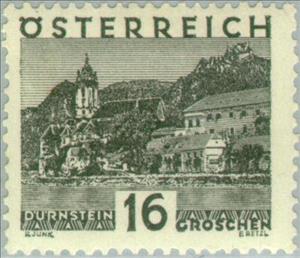Stamp: Dürnstein, Lower Austria - large format (Austria 1929)
Dürnstein, Lower Austria - large format (Austria 1929)
04 November (Austria ) within release Landscapes goes into circulation Stamp Dürnstein, Lower Austria - large format face value 16 Austrian groschen
| Stamp Dürnstein, Lower Austria - large format in catalogues | |
|---|---|
| Michel: | Mi:AT 501 |
| Yvert et Tellier: | Yt:AT 380 |
Stamp is horizontal format.
Also in the issue Landscapes:
- Stamp - Güssing Castle, Burgenland - large format, ochre face value 10;
- Stamp - Hoch-Osterwitz Castle, Kärnten - large format face value 15;
- Stamp - Dürnstein, Lower Austria - large format face value 16;
- Stamp - Traunsee, Upper Austria - large format face value 18;
- Stamp - Hohensalzburg Fortress, Salzburg - large format, maroon face value 24;
- Stamp - Seewiesen, Steiermark - large format face value 30;
- Stamp - Old Hofburg, Innsbruck Tyrol - large format face value 40;
- Stamp - Hohenems, Vorarlberg - large format face value 60;
- Stamp - National Library, Vienna face value 1;
- Stamp - Stefans Cathedral, Vienna face value 2;
Stamp Dürnstein, Lower Austria - large format it reflects the thematic directions:
A landscape is the visible features of an area of land, its landforms and how they integrate with natural or man-made features. A landscape includes the physical elements of geophysically defined landforms such as (ice-capped) mountains, hills, water bodies such as rivers, lakes, ponds and the sea, living elements of land cover including indigenous vegetation, human elements including different forms of land use, buildings and structures, and transitory elements such as lighting and weather conditions. Combining both their physical origins and the cultural overlay of human presence, often created over millennia, landscapes reflect a living synthesis of people and place that is vital to local and national identity. The character of a landscape helps define the self-image of the people who inhabit it and a sense of place that differentiates one region from other regions. It is the dynamic backdrop to people’s lives. Landscape can be as varied as farmland, a landscape park, or wilderness. The earth has a vast range of landscapes, including the icy landscapes of polar regions, mountainous landscapes, vast arid desert landscapes, islands and coastal landscapes, densely forested or wooded landscapes including past boreal forests and tropical rainforests, and agricultural landscapes of temperate and tropical regions.
A tower is a tall structure, taller than it is wide, often by a significant factor. Towers are distinguished from masts by their lack of guy-wires and are therefore, along with tall buildings, self-supporting structures.


